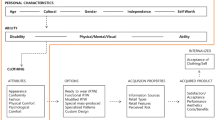Abstract
This paper presents conceptual designing of adaptive sportswear for wheelchair-bound tennis players of India. The present study combines user-centric design development principles with the design process of Lamb and Kallal (1992), for designing of functional adaptive sportswear, as there are limited researches in this area in the Indian context. Additionally, the conceptual design framework for wheelchair users’ sportswear comfort proposed by Lee and Jin (2019) has also been used for designing concepts. The problems faced by the users were studied using ethnographic research methods to identify certain demands prior to designing concepts for the wheelchair-bound players. The qualitative data has been collected through observations, the structured questionnaire with users and stakeholders (coaches, doctors, physiotherapists and caregivers). Additionally, infrared thermal imaging (thermography) techniques were used to study the changes in the skin temperature of the wheelchair-bound players and thermoregulation during the match in a real set up, prior to conceptualisation. A pilot study was done with the wheelchair tennis players at Karnataka State Lawn Tennis Association, Bengaluru for this study. During the study, it was observed that three out of five players have lost the mobility of their legs due to poliomyelitis. Therefore, the designing criteria have been proposed for wheelchair-bound tennis players who have lost the mobility of their legs due to poliomyelitis.
Access this chapter
Tax calculation will be finalised at checkout
Purchases are for personal use only
Similar content being viewed by others
References
Roy JL, Menear KS, Schmid MM, Hunter GR, Malone LA (2006) Physiological responses of skilled players during a competitive wheelchair tennis match. J Strength Cond Res 20(3):665
Boorady LM (2011) Functional clothing- principles of fit. Indian J Fibre Text Res 36(4):344–347
Kabel D, Black KM (2017) Clothing related barriers experienced by people with mobility disabilities and impairments. Appl Ergonom 59(Part A):165–169
John TJ, Vashistha VM (2013) Eradicating poliomyelitis: India’s journey from hyperendemic to polio free status. Indian J Med Res 137(5):881–894
Lamb JM, Kallal MJ (1992) A conceptual framework for apparel design. Cloth Text Res J 10:42–47
Hanington B (2003) Methods in the making: a perspective on the state of human research in design. Des Issues 19(4):9–18
Lee H, Jin H (2019) Conceptual design framework as a model for wheelchair users’ sportswear comfort. Fashion Text: Int J Interdiscipl Res 6:23. https://doi.org/10.1186/s40691-019-0179-z
Wingate SB, Kaiser SB, Freeman CM (1986) Salience of disability cues in functional clothing: a multidimensional approach. Cloth Text Res J 4(2):37–47
Fernandez-Cuevas I, Sillero-Quintana M, Garcia-Conception MA, Ribot-Serrano J, Gomez-Carmona P (2014) Monitoring skin thermal response to training with infrared thermography. New Stud Athlet 29(1):57–71
Goosey-Tolfrey V, Moss AD (2005) The velocity characteristics of wheelchair tennis players with and without the use of racquets. Adapt Phys Act Q 22:291–301
Croft L, Dybrus S, Lenton J, Goosey-Tolfrey V (2010) A comparison of the physiological demands of wheelchair basketball and wheelchair tennis. Int J Sports Physiol Perform 5:301–315
Fabrocini B (1995) The planning of a powerful trunk for tennis. Strength Cond:25–29
Kibler WB, McQueen C, Uhi T (1988) Fitness evaluations and fitness findings in competitive junior tennis players. Clin Sports Med 7:403–416
Johnson JM (1992) Exercise and the cutaneous circulation. Exerc Sport Sci Rev 20:59–97
Robinson S (1963) Temperature regulation in exercise. Pediatrics 32(Suppl):691–702
Ferrara MS, Davis RW (1990) Injuries to elite wheelchair athletes. Paraplegia 28:335–341
Chang WM, Zhao YX, Guo RP, Wang Q, Gu XD (2009) Design and study of clothing structure for people with limb disabilities. J Fiber Bioeng Inf 2(1):62–67
Author information
Authors and Affiliations
Corresponding author
Editor information
Editors and Affiliations
Rights and permissions
Copyright information
© 2021 Springer Nature Singapore Pte Ltd.
About this paper
Cite this paper
Bairagi, N., Bhuyan, S.K. (2021). Studies on Designing Adaptive Sportswear for Differently Abled Wheelchair Tennis Players of India. In: Majumdar, A., Gupta, D., Gupta, S. (eds) Functional Textiles and Clothing 2020. Springer, Singapore. https://doi.org/10.1007/978-981-15-9376-5_7
Download citation
DOI: https://doi.org/10.1007/978-981-15-9376-5_7
Published:
Publisher Name: Springer, Singapore
Print ISBN: 978-981-15-9375-8
Online ISBN: 978-981-15-9376-5
eBook Packages: Chemistry and Materials ScienceChemistry and Material Science (R0)




